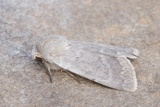Caradrina gilva (Donzel, 1837) Species
Last modified: Nov. 18, 2025, 5:55 p.m.
The first observation of this xeromontane species was in Belgium in 2011 (LI). Nowadays more observed and widespread but still very rare.
This species is considered Least Concern according to the IUCN Red List category for Flanders 2023.
Details
- Classification
- Family: Noctuidae > Subfamily: Xyleninae > Tribus: Caradrinini > Genus: Caradrina > Subgenus: Eremodrina > Species: Caradrina gilva
- Vernacular names
- Grauwe stofuil (NL), La Caradrine cendrée (FR), Reingraue Staubeule (DE)
- First mention in Belgium
- De Prins W., Steeman C. & Sierens T. 2015. Interessante waarnemingen van Lepidoptera in België in 2014 (Lepidoptera). — Phegea 43(4): 98–103. On page 102. view page
- Status
-
Native
Distribution
Bionomics
The species is usually observed in the vicinity of railways. The adults come to light.
No pictures yet!
Flight periods
The moths can be seen from May to mid-November, with a peak during June.
Habitat
Warm dry slopes on a rocky or stony surface, with open vegetation like railway embankments.
No pictures yet!



